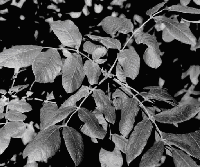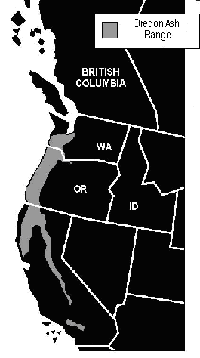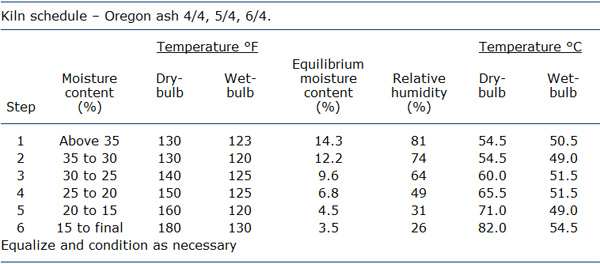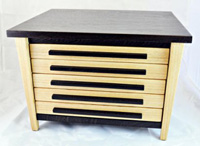 General Characteristics
General Characteristics- Biology & Management
- Harvest & Utilization
- Wood Properties
- Related Literature
- Oregon Producers and Users of Oregon ash
This information was originally published in Hardwoods of the Pacific Northwest, S.S. Niemiec, G.R. Ahrens, S. Willits, and D.E. Hibbs. 1995. Research Contribution 8. Oregon State University, Forest Research Laboratory
General Characteristics
Oregon ash, a member of the olive family (Oleaceae), is one of 16 species of ash in the United States. It is the only ash native to the Pacific Northwest.
 Size, Longevity, and Form
Size, Longevity, and Form
Mature Oregon ash attain heights of 60 to 80 ft and DBH of 16 to 30 in. Ash may live at least 250 years. In forest stands, Oregon ash develop short, narrow crowns with small branches on long, straight boles. Open-grown trees have broad, rounded crowns with large limbs on short boles. The root system of ash is moderately shallow, wide-spreading, and densely fibrous.
Geographic Range
Oregon ash is native from northern Washington (lat 48° N) to southern California (lat 35° N) on the west side of the Cascade Range and the Sierra Nevada. It is most common in valleys and along rivers.
Timber Inventory
The total inventory of Oregon ash (about 184 MMCF) is scattered across all subregions of Oregon and Washington (Appendix 1, Table 1). It is most abundant in the Columbia Basin and tributary streams and valleys in northwestern Oregon and southwestern Washington. The availability of Oregon ash for timber harvest is significantly restricted by regulations governing forestry practices in riparian areas and wetlands.
Biology and Management
Tolerance, Crown Position
Oregon ash is intermediate in tolerance, and commonly occurs in intermediate or codominant crown positions. Young seedlings will grow in fairly dense shade. Overtopped trees of any age can respond to release with openings in the overstory.
Ecological Role
Oregon ash is a long-term dominant in riparian areas along slow streams and in other poorly drained areas subject to seasonal flooding. It may replace cottonwood on heavy soils and on swampy ground with poor drainage during the growing season. Oregon ash seedlings will also colonize wet areas in grasslands and abandoned fields.
Associated Vegetation
Tree species commonly associated with Oregon ash are black cottonwood, red alder, white alder, bigleaf maple, Oregon white oak, California-laurel, California sycamore, and various willows. Douglas-fir, grand fir, and ponderosa pine are associated with Oregon ash on the drier margin of typical ash sites. Understory vegetation is sparse under dense stands; sedges often dominate under ash. Common shrub associates include snowberry, hawthorn, serviceberry, mockorange, crabapple, and himalaya berry.
Suitability and Productivity of Sites
Oregon ash is particularly suited to heavy soils and poorly drained areas, which are often too wet for any other tree, including cottonwood. Ash may grow very well outside of such areas, although management may be required to maintain it. Growth and stem form are often quite poor on poorer sites; the suitability of sites should be evaluated before effort is invested in management of Oregon ash.
The capability of a site for growing Oregon ash should be evaluated by examining growth and form of older trees. Good growth potential is indicated by the following:
- Top height on mature trees of at least 60 ft
- Sustained height growth of 1 to 2 ft per year at ages 5 to 20 years
- Continuing diameter growth on mature trees.
Climate
Oregon ash thrives in a mild, humid climate characterized by relatively cool, humid summers and wet, mild winters. In this climate, annual precipitation ranges from 20 to 118 in., with very little rain in July and August; mean annual temperatures range from 46 to 54°F.
The bottomlands where Oregon ash is most common provide a relatively cool, moist environment, even in hot interior valleys. Oregon ash has a fairly high tolerance to summer drought; however, it generally ceases growth and drops its leaves when conditions become hot and dry. Oregon ash that establish on drier sites often persist in a stunted, crooked form.
Elevation
Oregon ash usually grows at elevations from sea level to 3000 ft, although it may be found as high as 5000 ft.
Soils
Oregon ash typically grows on deep, poorly drained clays or silty clay loams that are rich in humus. It will also grow on sandy, rocky, and gravelly soils in riparian areas or areas with seasonal flooding. Oregon ash also grows on upland forest soils adjacent to more typical ash habitat.
Flowering & Fruiting
Oregon ash begins producing seed at about 30 years of age. Male and female flowers grow on separate plants. The greenish-white flowers (male and female) are borne in dense panicles, which appear at the base of new foliage in April or May. The fruits are oblong to elliptical samaras 1 to 2 in. long. They ripen in August or September, turning from green to light brown.
Seed
The winged seeds (10,000 to 14,000/lb) are dispersed by wind during September and October. Ash seeds can remain viable for more than one year; they usually require moist, cold stratification in order to germinate. Germination rates are medium to high.
Regeneration from Seed
Open-grown trees produce good seed crops almost every year. In forest stands, heavy crops of seed are produced every 3 to 5 years. Wet or moist soils high in organic matter provide the best conditions for germination and establishment of Oregon ash. Although many seeds are transported by flood waters, few seedlings establish from seeds deposited on sandy or gravelly stream beds. Seedlings commonly establish in the understory of existing riparian forests after floods that deposit silt. Ash seedlings also establish in wet grasslands or fields, particularly after disturbance such as plowing (in the absence of fire or grazing).
Regeneration from Vegetative Sprouts
Oregon ash sprouts vigorously from the root collar after cutting. Stumps should be cut low to the ground in order to produce well-formed sprouts of good quality.
Regeneration from Planting
The performance of Oregon ash has been poor to fair in limited outplanting trials. There are no known examples of operational forest plantations. Oregon ash is widely planted and does very well in ornamental applications, which indicates its potential for good performance in managed plantations.
Site Preparation and Vegetative Management
Little site preparation is necessary for establishing stands of sprout origin. Both mechanical and chemical treatment options may be limited on typical, wet Oregon ash sites. Although Oregon ash would probably benefit from control of competing vegetation on a site, established seedlings seem to grow well amidst substantial competition in old fields.
Stand Management
Oregon ash is not generally managed for timber production. Young ash trees grow fairly rapidly, but are commonly crooked or forked. Young stands are typically dense; early thinning to allocate stand growth to well-formed trees can improve stand quality. Older ash trees also respond to thinning; the diameter growth of crop trees doubled after crown-thinning in a dense, 45-year-old stand.
Mixed-species Stands
The shade tolerance of young Oregon ash trees and the ability of overtopped trees to respond to openings provide flexibility for management of ash in mixed species or age classes. Oregon ash are often mixed with cottonwood and bigleaf maple in bottomland forests, where flood waters maintain a variable disturbance regime. Management of these areas must integrate the range of growth rates, shade tolerance, and regeneration needs among associated species.
Growth and Yield
Growth of Oregon ash is moderately rapid for the first 60 years (1 to 2 ft per year). Thereafter, height growth is negligible and top height is relatively short (60 to 80 ft), although good diameter growth may continue. Early growth of stump sprouts is quite rapid (3 to 4 ft per year). There are few estimates of volume growth or yield for Oregon ash. Measurements in a pure stand of 45-year-old Oregon ash showed an average height of 70 ft and basal area of 140 to 160 ft2 per acre, which yield approximate volumes of 3200 to 3800 ft3 per acre. Annual growth was about 70 ft3 per acre in both lightly thinned and unthinned stands.
Interactions with Wildlife
Ribbonlike forests of Oregon ash along streams and sloughs provide an important forest habitat in valleys that are otherwise cultivated farm or pasture. Oregon ash provide food and habitat for beaver and nutria, which also significantly damage the trees. Deer and elk also browse Oregon ash seedlings and stump sprouts.
Insects and Diseases
Weevils (Thysanocnemis spp.) destroy significant amounts of seed (up to 60 percent). Various other insects feed on twigs and foliage and may be pests in ornamental plantings. A variety of fungi cause leaf spot and powdery mildew. True mistletoe grows on Oregon ash. A heart rot causes extensive defect in older trees, and hollow “stovepipe” ash are prevalent in some stands.
Genetics
Some of the stand-to-stand variation in the form of Oregon ash may have a genetic basis. There are no recognized varieties of Oregon ash, although it may hybridize with velvet ash (F. velutina) in the southern Sierra Nevada.
Harvesting and Utilization
Cruising and Harvesting
There are no equations or tables for calculating tree volume. Log grades have not been developed. Premium prices may be paid for logs 12 in. and larger. Harvesting of Oregon ash may often be subject to restrictions for protection of riparian zones or wetlands.
Product Recovery
Sawlogs usually have a minimum small-end diameter of 6 in. The relatively small volume of sawlogs that are harvested are fully utilized, demand for lumber is relatively high. Lumber grade recovery has not been studied.
Wood Properties
Characteristics
The wood of Oregon ash is moderately hard and heavy, with distinct growth rings. The sapwood is nearly white and is wide. The heartwood is a yellowish-brown, with a slight greyish cast. The wood is somewhat lustrous. It has no characteristic odor or taste. Oregon ash wood is ring porous; the earlywood vessels are large, forming a band that is 2 to 4 pores in width and distinctly visible to the naked eye. The transition to latewood is abrupt. Latewood pores are small, barely visible to the naked eye. The variability between earlywood and latewood is especially apparent on flat-sawn surfaces, where the denser latewood markedly contrasts with the porous, grainy earlywood. Rays are not easy to distinguish with the naked eye.
Weight
Oregon ash weighs about 48 lb/ft3 when green and 38 lb/ft3 at 12 percent moisture content (MC). The average specific gravity is 0.50 (green) or 0.55 (ovendry).
Mechanical Properties
Because Oregon ash is moderately hard and heavy, it is rated intermediate in bending strength and stiffness. Its impact resistance, however, is rated as high. Its hardness and compressive strength is good; thus it is well suited for most furniture, paneling, or flooring applications. Nail and screw splitting are less problematic than with other, more dense woods such as oak. The nail-holding ability of Oregon ash is good. Appendix 1, Table 3 provides information on clear strength values for Oregon ash, as well as comparative values of other species.
Drying and Shrinkage
Under moderately controlled conditions, Oregon ash dries rapidly and with minimal degrade. Drying defects are most often associated with wetwood, or are caused by uncontrolled air-drying, which results in surface- and end-checking. Sapstains and sticker stains can also degrade the wood. Green MC of Oregon ash wood averages 49 percent. Shrinkage values for Oregon ash dried from green to ovendry are 4.1 percent radially and 8.1 percent tangentially. These values are similar to other ash species. The table below provides an appropriate dry-kiln schedule. For thicker stock, contact the Forest Product Department at OSU for additional schedules.

Machining
Oregon ash machines without much difficulty. It planes and shapes favorably; ash is comparable to bigleaf maple in shaping qualities, and slightly below the oaks in planing qualities. It turns well and, when holes are bored in ash, the holes are smooth with minimal size variation. Fuzzing from sanding is rare, although surface scratching can be apparent, especially on the latewood parts of flat-sawn boards. The best results in planing are obtained with tooling that has a 25° hook angle. Tool wear is moderate.

Adhesives
Oregon ash bonds satisfactorily and there are no unusual problems when conditions are well controlled. Because of its light color, the glue line can be visible on sapwood if darker resins are used.
Finishing
The natural luster of Oregon ash is enhanced with clear finishes or transparent dyes. The earlywood vessels may require filling to minimize surface texture. Heavily pigmented stains tend to darken the more porous earlywood without penetrating the denser latewood. Color variation between sapwood and heartwood can present problems if a uniform color is desired. Surface scratching in the dense latewood can sometimes be a problem.
Durability
Oregon ash is a nondurable species that is susceptible to wood decay. Untreated posts of this wood average only 6 years of service before failing. Heartwood of ash species is considered easily penetrated with preservative solutions. The wood is subject to attack by powder post beetle (Ptilinus basalis) and is moderately susceptible to sapstain, mold, and iron stain.
Uses
Oregon ash is used for furniture, cabinets, paneling, veneer, tool handles, flooring, millwork, pallets, crates, boxes, and firewood.
Related Literature
FRENKEL, R.E., and E.F. HEINITZ. 1987. Composition and structure of Oregon ash (Fraxinus latifolia) forest in William L. Finley National Wildlife Refuge, Oregon. Northwest Science 61:203-212.
HIBBS, D.E., and G.R. AHRENS. Unpublished data. Forest Science Department, Oregon State University, Corvallis.
OWSTON, P.W. 1990. Oregon ash. P. 339-343 in Silvics of North America. Volume 2, Hardwoods. R.M. Burns and B.H. Honkala, coords. USDA Forest Service, Washington D.C. Agriculture Handbook 654.
